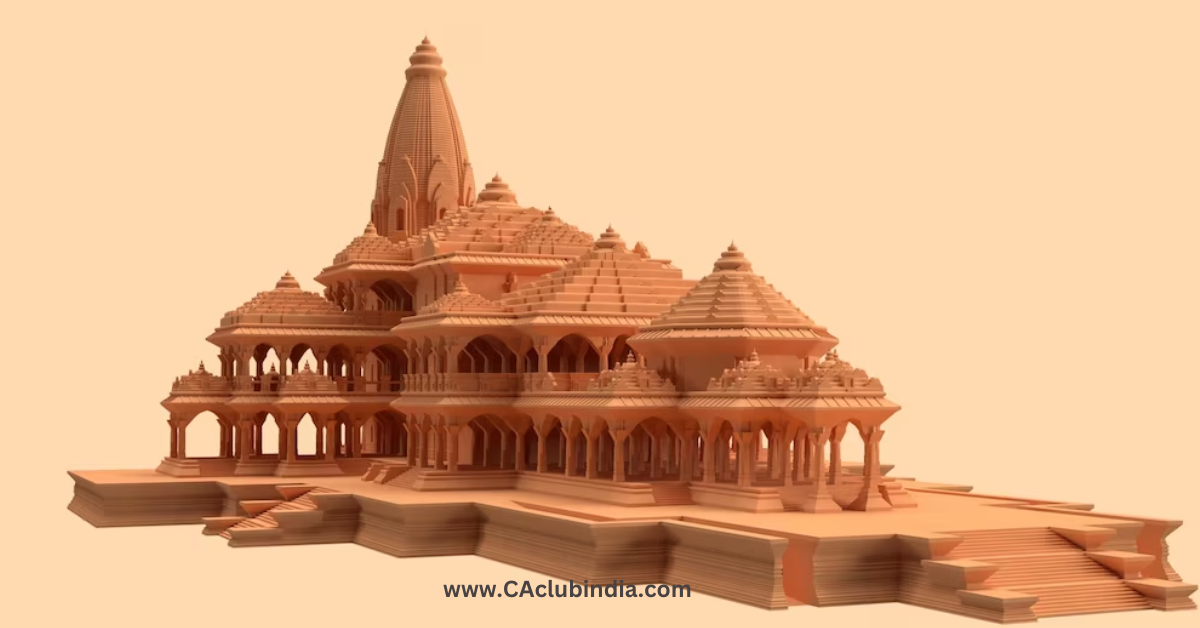Income Tax Department Grants Deductions for Donations to Ram Mandir Renovation: A Detailed Insight into Section 80G Benefits
The Income Tax department has provided clarity on the eligibility of donations made towards the repair, rebuild, or renovation of the Ram Mandir in Ayodhya, administered by the Shri Ram Janmabhoomi Teerth Kshetra Trust. According to the latest notification, such contributions are now eligible for deductions under Section 80G(2)(b) of the Income-tax Act, 1961.
The government's announcement outlines that 50 percent of the donation amount allocated for the purpose of temple repair or renovation qualifies for this deduction. It is crucial to understand that cash donations exceeding Rs 2,000 will not be eligible for this tax benefit.
The Central Board of Direct Taxes (CBDT) has explicitly affirmed that donations made to the Shri Ram Janmabhoomi Teerth Kshetra Trust are eligible for this tax benefit. This move comes as part of the government's effort to encourage contributions towards the restoration and upkeep of cultural and religious heritage sites.

Understanding Section 80G and Eligibility Criteria
Section 80G of the Income Tax Act, 1961, addresses deductions for donations to specific funds, charitable institutions, and more. The recent notification by the Central Government specifically designates "SHRI RAM JANMABHOOMI TEERTH KSHETRA" (PAN: AAZTS6197B) as a place of historic importance and a renowned site of public worship. This designation makes it eligible for deductions under Section 80G(2)(b) starting from the financial year 2020-2021.
The move is expected to incentivize individuals and entities to contribute towards the preservation and enhancement of cultural and religious landmarks. It not only recognizes the significance of the Ram Mandir in Ayodhya but also aligns with the government's broader initiatives to protect and promote India's rich heritage.
This clarification by the Income Tax department not only sheds light on the eligibility criteria for deductions but also emphasizes the government's commitment to preserving and fostering cultural and religious diversity in the country. As individuals and organizations consider their philanthropic endeavors, this new provision opens avenues for contributing to the restoration and maintenance of iconic structures that hold deep cultural and historical significance.
A Step-by-Step Guide: How to Make Secure Donations to Ram Mandir Through Shri Ram Janmabhoomi Teerth Kshetra Trust
As the construction of the Ram Mandir gains momentum, individuals keen on contributing to this historic endeavor can follow a simple guide to ensure a smooth and secure donation process through the Shri Ram Janmabhoomi Teerth Kshetra Trust. Here's a comprehensive step-by-step walkthrough:
Step 1: Visit the Official Website
Head over to the official website of the Shri Ram Janmabhoomi Teerth Kshetra Trust: https://srjbtkshetra.org/
Step 2: Click "Donate"
Look for the "Donate" tab on the main page of the website and click on it to initiate the donation process.
Step 3: Log in/Register
You can either log in using your mobile number and OTP or register by providing your details. This step is crucial for maintaining the security of your donation information.
Step 4: Choose a Bank Account
Select one of the three authorized bank accounts for the Trust: State Bank of India (SBI), Punjab National Bank (PNB), or Bank of Baroda (BoB). Non-Indian passport holders can find the bank account details on the official website.
Step 5: Fill in Your Information
Provide essential details such as your name, purpose of donation, PAN number, donation amount, address, mobile number, and email ID. Accuracy in these details is important for transparency and record-keeping.
Step 6: Make the Payment
Choose your preferred payment method from the options available, including a payment gateway, UPI, NEFT, IMPS, demand draft, or cheque.
Step 7: Download the Receipt
Upon successful payment, you'll receive a donation receipt. Make sure to download and keep this receipt for your records.
Important Points to Note
- Official Channels Only: Ensure that your donation is made exclusively through the official website or using the mentioned bank accounts to avoid falling victim to fraudulent activities.
- Cash Donations Limit: Cash donations exceeding Rs. 2,000 are not eligible for tax deductions. Opt for other payment methods to make the most of the benefits available.
- Tax Deductions: You can claim a 50% deduction on your taxable income for donations made towards the renovation or repair of the temple under Section 80G of the Income Tax Act. However, it's crucial to choose the old tax regime while filing your Income Tax Return (ITR) to avail of this benefit.
- Keep the Receipt: The donation receipt serves as proof for claiming tax deductions, so ensure it is stored safely.
By following this guide, contributors can actively participate in the construction of the Ram Mandir, knowing that their donations are secure, transparent, and aligned with the legal framework governing such philanthropic activities.





 CAclubindia
CAclubindia


